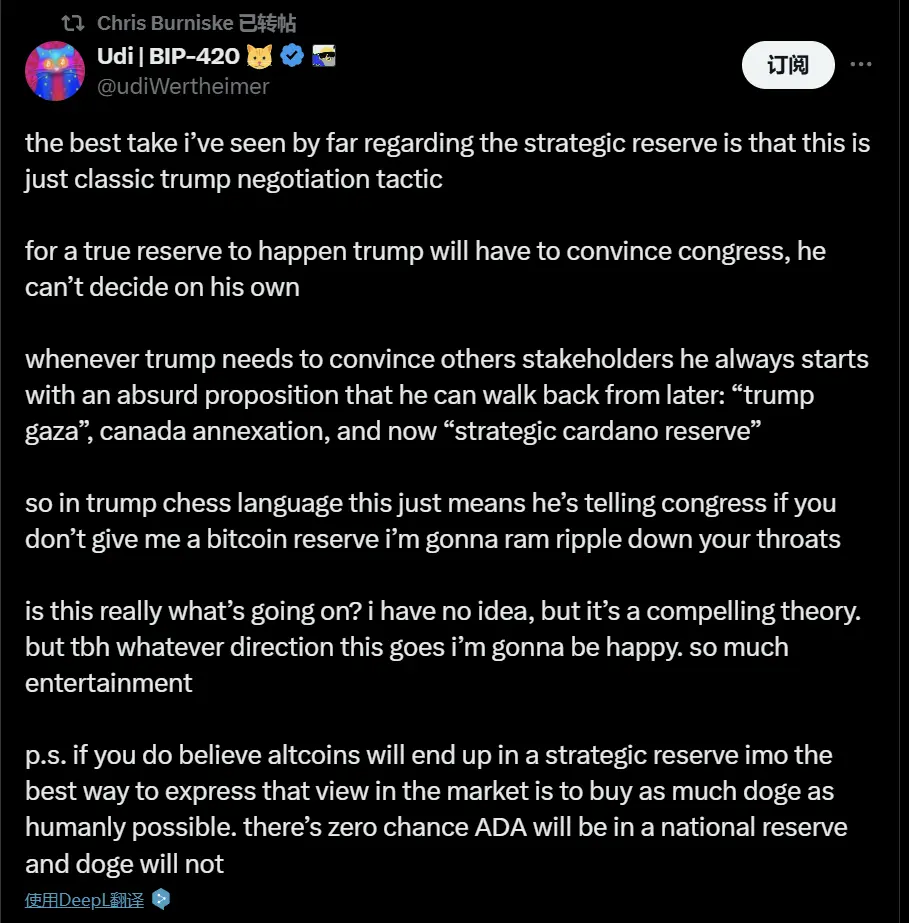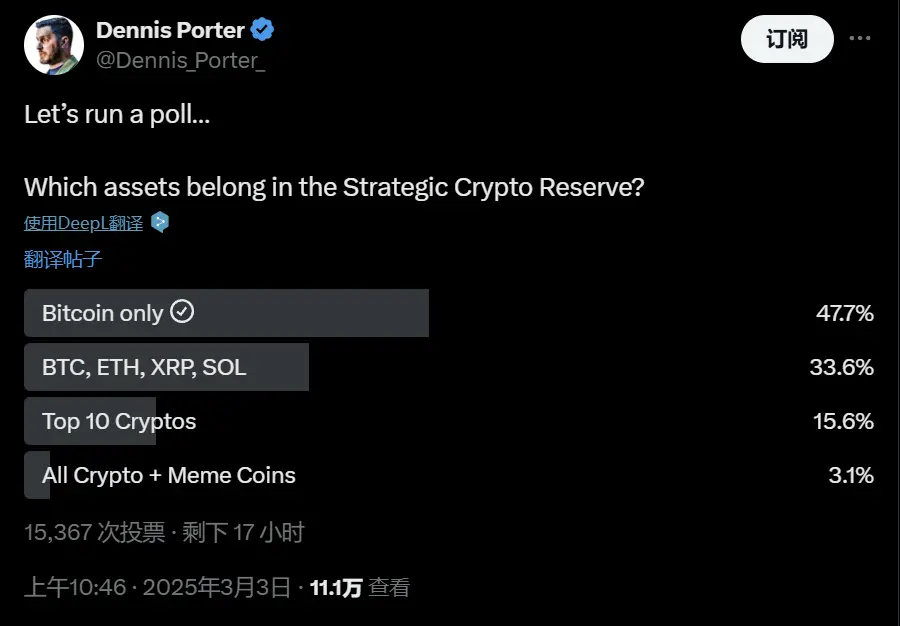Author: Speechless Scof, ChainCatcher
Last night, the cryptocurrency market was in a frenzy due to a post by Trump mentioning the "crypto strategic reserve". XRP, SOL, and ADA soared by more than 30% in a single day, and Bitcoin and Ethereum followed suit. The market value of the entire crypto market surged by US$300 billion.
The "pulling up" effect is obvious, but the market does not seem to have reproduced the past enthusiastic cheers for the policy bull market.
Crypto rationality is returning.
1. Crypto Rationalists: Rather than a strategic reserve, it is more like a strategic pull
Anyone who understands the U.S. legislative system knows that the president does not have the power to unilaterally establish a national crypto reserve, which would require a long and complicated game in Congress.
Although the latest progress of the "Cryptocurrency Strategic Reserve" has boosted market sentiment in the short term, some industry insiders are skeptical of Trump's crypto reserve plan. More rational voices believe that the plan is more like a political gesture or negotiation strategy than a truly executable national strategy.
Crypto analyst Arthur Hayes said bluntly on the day of the surge: "This is just a blank check. The U.S. Treasury simply does not have the budget to increase its holdings of crypto assets."
Chris Burniske, partner of Placeholder VC, retweeted the views of Udi Wertheimer, founder of Taproot Wizards, on social media: So far, the best interpretation of the strategic reserve is that this is just a typical Trump negotiation strategy. To achieve a real reserve, Trump must convince Congress, and he cannot decide on his own. Whenever Trump needs to convince other stakeholders, he always starts with a ridiculous proposal, and then he can back off, such as the previous Gaza plan, the annexation of Canada, and now the ADA strategic reserve. So, in Trump's "chess game language", this means that he is telling Congress: If you don't agree to the Bitcoin reserve, I will propose more outrageous conditions.

Alex Xu, research partner at Mint Ventures, pointed out that since Trump took office, SOL, XRP, and ADA have frequently interacted with Mar-a-Lago and publicly supported Trump, such as donating to the inauguration fund. The private transfer of interests may be more complicated, and Trump's statement this time can be seen as a return for these supports to some extent, providing him with an "advertising space" within the scope of the president's authority.
2. It is not very reliable to include assets such as ADA and XRP in the national reserve
In the long run, it is not only unfeasible to include assets such as ADA and XRP in the national reserve, but it will also weaken the seriousness of Bitcoin as a strategic reserve asset, making it further less likely that relevant legislation will be passed at the federal level. It is one thing to let the working group study and promote it, but it is another to actually legislate. The Republicans' slight advantage in the House of Representatives means that it is almost impossible for them to promote legislation to include SOL, ADA, and XRP in the national reserve.
At present, the only realistic possibility is that Trump bypasses Congress and uses administrative means to let the Treasury Department directly establish a national sovereign fund to purchase these assets. However, the feasibility of this move is questionable. How much political and economic benefits do SOL, XRP, and ADA need to provide for this to prompt the president to order the purchase with taxpayers' funds?
As Aave founder Stani Kulechov quipped: “Good news: strategic crypto reserves in the works; bad news: lack of DeFi; ugly news: XRP, SOL, and ADA.
Dennis Porter, co-founder and CEO of Satoshi Action Fund (SAF), launched a poll on X, asking “Which assets belong in strategic crypto reserves?” The survey aims to gather the crypto community’s views on which digital assets should be considered strategic reserves.
As of now, there are 15,367 votes in total, with 47.7% supporting the inclusion of only BTC; 33.6% supporting the inclusion of BTC, ETH, XRP and SOL; 15.6% supporting the inclusion of the top ten cryptocurrencies by market capitalization; and 3.1% supporting the inclusion of all cryptocurrencies and Meme coins.

There is no need to say much about the public opinion trend.
3. Bullish trend? But retail investors are not back yet
Faced with such a market, although they are shouting "The bull market is back, come back soon!", retail investors who have experienced several rounds of bull-bear market transitions have long learned to be wary of sudden surges. They are also worried that this overly manipulated market will see another black swan.
In the view of crypto KOL @ DtDt666, "Although the market has risen in the short term, the current cryptocurrency circle is chilling. The operation is as fierce as a tiger, and the rise and fall all depend on Trump." This sentence vividly describes the current market structure - the originally decentralized crypto world is being reshaped by capital and political forces, and the Trump family seems to have become the most important player in this game.
But the question is, is this market boom based on political cycles really conducive to the long-term development of the crypto industry? Although Trump's remarks briefly boosted market sentiment, they caused the crypto industry to ponder.
After all, crypto’s independent narrative and growth flywheel have yet to be established.











